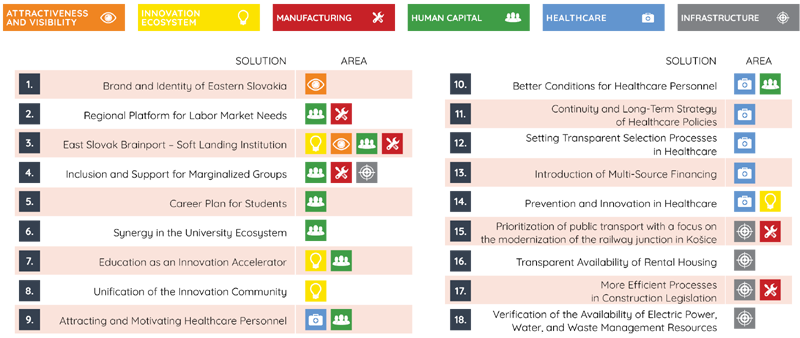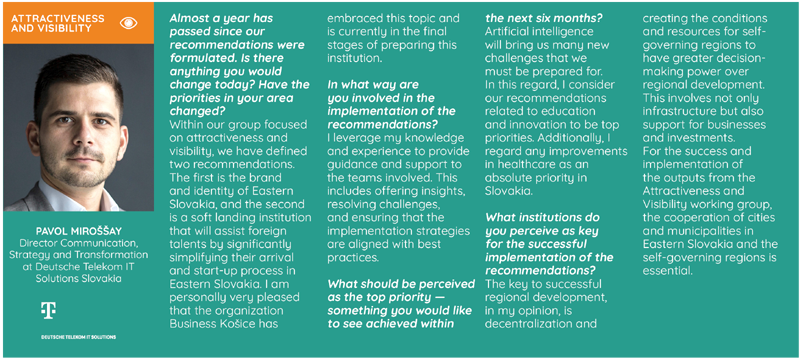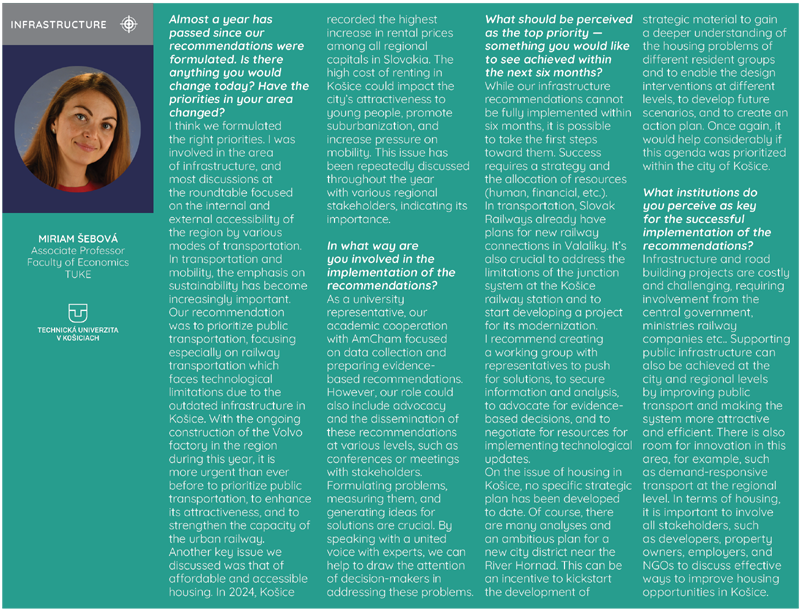
1 - Brand and Identity of Eastern Slovakia
Challenge:
The Eastern region of Slovakia faces a challenge caused by the absence of a unified and comprehensive marketing approach – a brand and identity. There is persistent fragmentation of expressive means among individual municipalities and various organizations, resulting in significant confusion and low effectiveness of the entire effort in promoting the region. Moreover, for people coming from abroad, the territorial-administrative division is often very confusing, and they better understand the expression ‘Eastern Slovakia.’
Solution:
We propose creating a “brand” manual that will serve as a guideline for creating and spreading awareness of the Eastern Slovak region as a whole. The manual should be created under the auspices of a non-profit organization specifically established for this purpose, symbolically bringing together various entities located in Eastern Slovakia, especially the counties and cities. Subsequently, they would use the brand in broader communication and in promoting themselves and their activities, thus creating a unified image, or identity, of Eastern Slovakia. As part of the communication, selected individuals, “storytelling ambassadors,” would present positive aspects of the region. The goal is to create a narrative about the successful story of Eastern Slovakia, supported by organizing globally significant events in the region, using the brand of Eastern Slovakia.
2 - Regional Platform for Labor Market Needs
Challenge:
One of the most significant challenges facing the Slovak economy is the long-term mismatch between the content/format of education and the actual needs of the labor market. A substantial portion of graduates from secondary and tertiary institutions within five years of completing their studies continues to find employment outside their field of study. Taking broader societal needs into account, from the perspective of employers and the state, the employability of graduates in their respective fields serves as the most credible feedback on the quality of the educational process.
Solution:
We propose the establishment of an informal but fully functional Eastern Slovak regional platform for labor market needs, jointly managed by the Košice and Prešov self-governing regions. Its goal should be the systematic and professional forecasting of local labor market needs for the purpose of optimally adjusting educational policies and effectively monitoring employer requirements. The platform would meet in person twice a year and work continuously with representatives of employers, local schools, and the state to regularly update the educational policies of both regions. The platform’s activities will contribute to proper planning and structuring of schools in line with the region’s needs, and to better connecting education policymakers with the business sector.

3 - East Slovak Brainport – Soft Landing Institution
Challenge:
Future labor market needs require foreign labor force and active engagement with the Slovak diaspora abroad. Slovaks abroad often worry about whether they will be able to adapt upon returning and whether the region has something to offer. Foreign labor coming to the Eastern Slovak region also faces various challenges, including administrative obligations, familiarization with the educational infrastructure and healthcare system, as well as finding suitable housing. Public administration, as the first point of contact, is often insufficiently prepared in terms of capacity for effective communication and assistance.
Solution:
Both dimensions of this challenge should be easier to solve by the so-called one-stop-shop, which will help make the region more attractive to foreign talent and the diaspora by creating a functional office/first-contact point in the East. This entity should also promote eastern Slovakia globally, create content for a portal with local job opportunities, and collaborate with local institutions to support language mutations in providing key public services. The non-profit model, involving regions, cities, associations, chambers, and business partners, appears to be the most suitable. This solution aims to intertwine with existing platforms and draw from them.
4 - Inclusion and Support for Marginalized Groups
Challenge:
The majority of the Roma population in the country resides in Eastern Slovakia. It represents a significant economic and social potential that remains untapped. Only a few private and public employers systematically work with the Roma community. Many municipalities establish communal enterprises that assist the Roma population in acquiring work habits, basic knowledge of labor law, and financial literacy. Employers emphasize the need to develop these habits from childhood. Therefore, we are convinced that, in the long term, primary schools are key to unlocking the potential of the Roma.
Solution:
We believe that, in line with the ‘talent attracts talent’ approach, it is necessary to connect successful members within the Roma community and identify role models. We propose that the regional platform for labor market needs, in collaboration with employers and non-governmental organizations, pilot the project ‘Promotion of Roma Ambassadors’ to support informal education and employment preparation. Simultaneously, we suggest selecting ten primary schools with a high percentage of Roma students as a pilot project for prioritizing curriculum reform in marginalized Roma communities by 2026 and opening a new call for proposals for this purpose from the Recovery Plan funds.
5 - Career Plan for Students
Challenge:
According to OECD data, every fifth high school graduate from Slovakia leaves the country and this has been a long-term trend. A survey by Talent Solutions Slovakia revealed that up to 22% of university graduates in Eastern Slovakia move abroad for work. We advocate for increasing the attractiveness of high schools and universities in Eastern Slovakia and aligning the structure of tertiary education with OECD standards (strengthening profession-oriented bachelor’s programs). We urge representatives of universities to collaborate more closely with high schools, NGOs, and chambers of commerce to work on preparing career plans for students and supporting career/educational advisors.
Solution:
One of the solutions to retain and develop talent in Eastern Slovakia is to establish an effective career and education advisory system. The platform of professional career and education advisors at the regional level aims to communicate career opportunities to students and enhance the attractiveness of university education in the region. We propose organizing a series of group meetings between employers and career advisors in various cities. We recommend continuing the concept of ‘dual education’ and expanding the educational activities of the Innovation Center of the Košice Region at high schools.
6 - Synergy in the University Ecosystem
Challenge:
The most significant societal change since the 19th-century industrial revolution has long begun, impacting people, companies, schools, local governments, and the state. Altered business models, new types of job positions, the impact of artificial intelligence, revolutionary changes in employment relationships, and the accelerated need for new skills profoundly affect the functioning of society. We see the key to a successful economic transformation of Eastern Slovakia in strengthening multidisciplinary activities in education and research, with the goal of producing highly skilled university graduates possessing multidisciplinary skills and competencies.
Solution:
We recommend that universities in Eastern Slovakia create a so-called competence map to effectively connect their priorities with the priorities of employers and other regional stakeholders. We encourage universities not to establish new departments but rather create hubs or joint entrepreneurial centers with a business plan, leading to sustainable financing of multidisciplinary activities within the university. We perceive career centers and centers for business consulting and innovation as proper solutions to strengthen synergies in the university ecosystem.

7 - Education as an Innovation Accelerator
Challenge:
The profile and skills of graduates often do not match the needs of the job market. The task of universities is to produce graduates with not only hard skills and education but also soft skills that enable them to be sufficiently adaptable and creative upon entering the job market. This requires an education system open to innovative teaching methods and systematic, institutionalized collaboration with the private sector.
Solution:
One possible solution is the introduction of a so-called acquisition tax. This solution changes the way public universities are funded based on an external key, allowing employers to allocate a certain percentage of their tax contribution to a specific purpose in the field of education. The second, continuous solution is to leave the decision on funding in the hands of the state but modify the evaluation criteria of universities for resource redistribution to better reflect meaningful activities in the field of innovative education and support for science and research. Working with young talent and students and integrating entrepreneurial skills training into education is also of utmost importance. These activities, as well as collaboration with the startup community and aspiring entrepreneurs, could be incorporated into the evaluation criteria for universities.
8 - Unification of the Innovation Community in Eastern Slovakia
Challenge:
Today’s society is significantly fragmented, and this is reflected in the innovation sector of Eastern Slovakia. One reason is a significant level of distrust toward public institutions. However, we attribute the fragmentation of the innovation environment mainly to the large number of different platforms, clusters, authorities, and organizations dedicated to this issue. Although these entities act with good intentions, the lack of common coordination and communication often leads to discord or even contradictory actions.
Solution:
We propose two possible solutions. The first is the creation of a platform that, as a politically independent authority, ensures the coordination of innovative initiatives in Eastern Slovakia. This solution, based on innovative leadership and mentoring, would support the establishment of new and existing platforms and promote successful stories of collaboration. This independent authority should also contribute to minimizing the abuse of platforms to pursue individual interests. The second solution is the creation of an informal platform for joint education of leaders in the innovation community. Within this joint educational process, leaders of the innovation ecosystem would learn to view challenges and their solutions from the same perspective.
9 - Attracting and Motivating Healthcare Personnel
Challenge:
Slovakia has been facing a long-term shortage of healthcare personnel, especially nurses and healthcare specialists – it lacks approximately 15,000 nurses and 2,000 doctors. According to trendprace.sk and the overall forecast of additional workforce needs, the healthcare and social assistance sector ranks 1st in the Košice Self-Governing Region and 3rd in the Prešov Self-Governing Region. While increasing the salaries of healthcare workers is important, it alone is not a solution to the situation.
Solution:
Based on the analysis of the current situation, it is necessary to identify obstacles and opportunities. The goal of such an analysis would be to improve legislative conditions and the effective implementation of non-legislative measures, as well as to attract and motivate qualified healthcare personnel. The analysis should assess the professional readiness of healthcare workers, their competencies, administrative burden, experience, continuous education, as well as the quality of performance. The proposals should also consider the redistribution of competencies, especially regarding practical nurse/administrative worker vs. nurse vs. doctor, aiming to increase the availability of healthcare.

10 - Better Conditions for Healthcare Personnel
Challenge:
The question of the quality of the working environment in healthcare contributes to the trend of healthcare personnel moving from the east to the west, both nationally and internationally. One reason for this shift is the more attractive conditions for performing healthcare professions in terms of the actual activity and the working environment, available tools, methods, and treatment. The Slovak healthcare system faces an excessive amount of administrative burden, often duplicative and uncoordinated, which reduces the attractiveness of performing healthcare professions in Slovakia, negatively impacting patient care.
Solution:
Maintaining and attracting qualified workers, even in less developed regions, requires improving working conditions, starting with an analysis of current deficiencies and potential. The next step should be the development of recommendations applicable at both regional and individual levels, based on the evaluation of satisfaction and the quality of healthcare provided in successful facilities, focus groups with representatives of healthcare providers, public administration, and educational institutions. The goals should include increasing the ratio of professional activities, reducing administrative burden, and creating a more motivating working environment.
11 - Continuity and Long-Term Strategy of Healthcare Policies
Challenge:
Despite the existence of numerous strategic documents, national programs, and action plans, the Slovak healthcare system fails in implementing approved measures and tracking set goals. The main reasons include low awareness and a lack of commitment from managerial staff, insufficient emphasis on their implementation, unsystematic monitoring, and a lack of impact analysis, including the impact on regional development. A long-term reactive approach to current crises and neglecting collected and analyzed data significantly affects the implementation of a long-term healthcare development strategy and delays the introduction of systematic changes at the regional level.
Solution:
When selecting and appointing managerial staff in public healthcare organizations in Slovakia, we recommend emphasizing knowledge of relevant strategic documents and legislation relevant to the performance of the given function. For managerial personnel, it is also necessary to set individual measurable indicators contributing to the fulfillment of the long-term strategy for the development of Slovak healthcare. Representatives of public administration, healthcare and social service providers, educational institutions, and the business sector should be involved in formulating these indicators. Meeting these indicators, monitored by the Ministry of Health, should influence the evaluation of their performance.
12 - Setting Transparent Selection Processes in Healthcare
Challenge:
The management of Slovak healthcare faces frequent and unpredictable changes. In the 30 years of independence, Slovakia has had more than 20 health ministers. Frequent changes also occur in the position of the general director of the National Health Information Centre (NCZI), in the leadership of state hospitals, emergency services, specialized national institutes, and the state health insurance company. Some nominations raise questions about the competence of the candidates. Frequent changes in leadership result in the disruption of integrity, credibility of individuals and institutions, processes, strategic direction, and they affect the daily operations of institutions.
Solution:
We recommend, based on expert dialogue, to examine current procedures, legislative and qualification requirements for the selection and nomination of individuals to managerial positions in public organizations in Slovak healthcare. The result should be a proposal for measures to increase trust and transparency in the process, especially ensuring the required expertise and competence of nominated individuals. Part of the solution should be the establishment of a professional commission as an advisory body for the Minister of Health to minimize previous negative experiences. We recommend introducing clear professional and ethical standards and considering the implementation of longer mandates.

13 - Introduction of Multi-Source Financing
Challenge:
Public spending on healthcare in Slovakia as a percentage of GDP in 2012 reached 5.46%. In 2020, it was 5.81% of GDP, while the EU average was 8.82%. Slovak nominal healthcare spending per capita was just under €1000 in 2020, significantly below the EU average of €2655. Countries with higher investment rates show better system performance as well as individual indicators. The lack of financial resources affects the possibilities, quality, and availability of provided healthcare.
Solution:
For the sustainability and development of the system, it is necessary to increase resources and improve their economic and strategic allocation. We recommend exploring options for increasing healthcare financing, including opening a discussion on patient entitlement, fees, and support for funding from sources other than public ones. Recommendations should also include an increase in state contributions for insured individuals to approach countries with higher quality healthcare. Discussion on defining the standard of healthcare provision and areas where decentralization and transferring competencies to the regional level could help increase the efficiency and specificity of healthcare provision is also needed.
14 - Prevention and Innovation in Healthcare
Challenge:
It is proven that early diagnosis of diseases reduces the system’s treatment costs and, in combination with innovative medical technologies and procedures, increases the number of healthy years of patients’ lives. However, low participation in prevention leads to the detection of diseases in later stages, increasing system costs and negatively impacting individual health. The European Medicines Agency (EMA) approved 168 innovative drugs for the period 2018-2021, while only 26 were available in Slovakia. In the Czech Republic, 99 were approved (EFPIA WAIT indicator 2023).
Solution:
We propose streamlining and shortening the process of introducing medical innovations (including diagnostics, drugs, and aids) based on the analysis of representatives from professional organizations, the private sector, public administration, and scientific research institutions. Within specialized workplaces, hospital facilities, or institutes, it is appropriate to support testing, research, and development of innovative procedures and treatment processes, for example by announcing the relevant call from the Recovery and Resilience Plan. In terms of prevention, it is necessary to analyze the status of preventive program fulfillment and screening measures to target them more specifically and increase their utilization by the population.
15 - Prioritization of public transport with a focus on the modernization of the railway junction in Košice
Challenge:
The railway signalling equipment of the Košice railway station operates on original technology from the seventies and significantly limits the flexibility and capacity of rail transport. There is a lack of flexible and efficient suburban train transport, which is critically needed in connection with the planned launch of the Volvo Cars Košice plant for two reasons. The first is the commuting of future plant employees, and the second is the export of its production. According to traffic models, individual commuting of employees would cause a traffic collapse at most intersections in the city of Košice. Currently, the southeast bypass of Košice is under construction as part of the expressways R2/R4. However, only one section of its construction is currently in the implementation stage, namely the part from the D1 highway Košické Oľšany to the Košice - south intersection near Šebastovce. It is the first section of the construction of this road, Šaca – Košické Oľšany, which is critically important, and unfortunately it is still in the process of land settlement, which poses a risk of delaying the construction work. On the other hand, the year-on-year increase in overall car traffic in the city (2% per year) is also an environmental problem because it worsens the quality of air, life, and health of the inhabitants in the Košice agglomeration.
Solution:
We propose prioritizing the modernization of the railway signalling of the Košice Railway Station. When it comes to road transport, it is essential to expedite the implementation of the first section of R2/R4. In this regard, we appeal for the acceleration of the land settlement process at the level of the relevant state authorities because its delay can significantly disrupt traffic flow upon the opening of the Volvo Cars Košice plant. However, a sustainable transport solution requires the maximum prioritization of all types of public transport in the region with the support of state institutions. This includes strengthening regular city transport and regional bus transport, along with introducing additional elements to prioritize public personal transport, whether in the form of implementing additional dedicated bus lanes or implementing active preference for public transport vehicles at traffic light-controlled intersections to reduce their delays and streamline their operation, thereby increasing the attractiveness of this system.

16 - Transparent Availability of Rental Housing
Challenge:
Currently, there is insufficient housing capacity in Košice. The availability of rental housing is a necessary condition for a good quality of life, as well as for the development of the city and the region as a whole.
Solution:
We propose the creation of a central registry of rental apartments that would facilitate the connection of involved parties (landlord, employer, employee). The goal could be to establish a nationwide registry based on legislative regulation, but in the initial phase, the registry could be initiated as a pilot innovative project of the City of Košice. Private owners of rental-suitable apartments would register for free with the city registry. The registry administrator would verify individual tenants. The advantage for the landlord is to gain a trustworthy and long-term tenant, and the advantage for the employer is collaboration with a trustworthy landlord. For the solution to be successful, it is essential to conduct an analysis of the availability of apartments with the potential to participate in the system, which will also consider the potential for the creation of new housing. Following subsequent discussions with all relevant stakeholders, we propose verifying the functionality of the project through pilot testing in the territory of the City of Košice and other cities in Eastern Slovakia.
17 - More Efficient Processes in Construction Legislation
Challenge:
Fragmented and unclear property relationships in the land registry are a significant obstacle in the construction of public infrastructure, technical, transportation, and green projects. This leads to the neglect of landscape care and very challenging revitalization of so-called ‘brownfields.’ Due to the neglected land registry, it is not possible to implement many good, environmentally beneficial, supported, and subsidized projects because cities and municipalities lack available land. The Slovak Land Fund (SPF) could partially assist by providing land more willingly or expediting exchange with the goal of realizing public-interest projects supported by the state.
Solution:
We recommend conducting a professional analysis to compare construction legislation with countries where the system operates efficiently. Subsequently implement selected best practices and, in collaboration with the state, create projects to support investments in the public interest during permitting processes for the construction of rental housing. The fundamental prerequisite for a successful pilot is simplifying the permitting processes for the construction of single-family homes with an area of 50-60 m2. The proposed solution will enable the utilization of financial resources and faster construction of housing, promoting affordable living, and increasing investor attractiveness. Additionally, we recommend conducting a review of technical standards at the local level and establishing an agency to support rental housing.
18 - Verification of the Availability of Electric Power, Water, and Waste Management Resources
Challenge:
Given the introduction of strategic innovations into the region, it is necessary to conduct an analysis of the availability of resources in the areas of water, waste, and energy management. This will allow the region to adequately prepare for the increased demands in these areas sufficiently in advance. As these topics fall under multi-level governance, it is essential to ensure cooperation between state authorities, public administration, and the private sector.
Solution:
Within a three-year time frame, we recommend the involvement of a wide range of stakeholders, mapping institutional security, ongoing activities, and projects of responsible institutions. Further, conduct an analysis of resources, predict needs, and specify targets for water consumption or energy regulations in light of the entry of strategic investors into the region. We also recommend analyzing the possibilities of utilizing green energy sources, their availability, capacity, and security. A key step is identifying potential insufficient resources for future projects and subsequently analyzing the feasibility of development projects focused on new resource acquisition possibilities, or decentralization and diversification of local resources. These steps will also require legislative adjustments.



Follow us